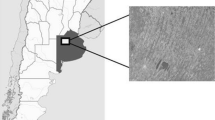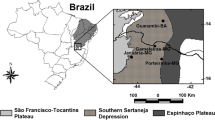Abstract
The aim of this study is to analyze the similarity of soils formed on limestone/marl alluvial parent material and different topography using some physical and chemical properties via cluster analysis (CA) and multidimensional scaling analysis (MDSA). Physical and chemical soil properties included in this study are texture, CaCO3, organic matter, pH, electrical conductivity, cation exchange capacity, and available water content. The study was carried out in Çetinkaya region located on Bafra Deltaic Plain. The study area has two main physiographic units. The first one is the flat or gently slope alluvial lands (0–2 %), and the other one involves hills with slopes ranging from middle to steep (3–20 %). The soil in the study area is mainly classified as entisol, inceptisol and vertisol. According to the CA results, while C horizons of the soils formed on alluvial deposits (typic ustifluvent and typic ustipsamment) bear similarity, Ap horizons of the soils formed on lime/marl parent material (vertic ustorhent, vertic calciustept, and calci haplustert) appear in the same group. Additionally, in order to support CA, MDSA was performed. Significant correlations were observed between the results of both analyses.



Similar content being viewed by others
References
Aimrun, W., Amin, M. S. M., Ahmad, D., Hanafi, M. M., & Chan, C. S. (2007). Spatial variability of bulk soil electrical conductivity in a Malaysian paddy field: key to soil management. Paddy and Water Environment, 5, 113–121.
Allison, L. E., & Moodie, C. D. (1965). Volumetric calsimeter method. In C. A. Black (Ed.), Methods of soil analysis. Part II: Chemical and microbiological properties (pp. 1389–1392). Madison: ASA Agronomy Monograph.
Bruce, R. C., & Rayment, G. E. (1982). Analytical methods and interpretations used by the agricultural chemistry branch for soil and land use surveys. Indooroopilly, Queensland: Queensland Department of Primary Industries, Bulletin QB8 (2004).
Dengiz, O., Sağlam, M., Özaytekin, H. H., & Başkan, O. (2013). Weathering rates and some physico-chemical characteristics of soils developed on a calcic toposequences. Carpathian Journal of Earth and Environmental Sciences, 8(2), 13–24.
Gee, G. W., & Bauder, J. W. (1986). Particle-sieze analysis. In A. Klute (Ed.), Methods of Soil Analysis. Part I: Physical and mineralogical methods (2nd ed., pp. 388–409). Madison: ASA and SSSA Agronomy Monograph.
Hendershot, W. H., Laareae, H., & Duquette, M. (1993). Soil reaction and exchangeable acidity. In M. R. Carter (Ed.), Soil sampling and methods of analysis (pp. 141–145). Boca Raton: Lewis.
İşler, D. B. (2010). Multidimensional scaling analysis. In Ş. Kalaycı (Ed.), Multivariate statistical techniques SPSS applied (pp. 379–386). Ankara: Asil Publication Distrubition Limited Company.
Jackson, M. L. (1958). Soil chemical analysis. New Jersey: Prentice Hall, Inc., Engleewood Cliffs.
Juma, N. G. (1999). What is soil? Major components of soil. In: The pedosphere and its dynamics. A systems approach to soil science. http://www.Pedosphere.com.
Klute, A. (1986). Water retention: Laboratory methods. In A. Klute (Ed.), Methods of soil analysis. Part I: Physical and mineralogical methods (2nd ed., pp. 635–662). Madison: ASA and SSSA Agronomy Monograph.
Metson, A. J. (1961). Methods of chemical analysis for soil survey samples. Soil Bureau Bulletin No 12, New Zealand Department of Scientific and Industrial Research (pp. 168–175). Wellington: Government Printer.
Mulla, D. J., & McBratney, A. B. (2000). Soil spatial variability. In M. E. Summer (Ed.), Handbook of soil science (pp. A-321–A-351). Boca Raton: CRS.
Rhoades, J. D. (1982). Soluble salts. In A. L. Page, R. H. Miller, & D. R. Keeney (Eds.), Methods of soil analysis. Part II: Chemical and microbiological properties (2nd ed., pp. 167–178). Madison: ASA and SSSA Agronomy Monograph.
Rhoades, J. D. (1986). Cation exchange capacity. In C. A. Francis (Ed.), Methods of soil analysis. Part II: Chemical and microbiological properties (2nd ed., pp. 149–158). Madison: ASA and SSSA Agronomy Monograph.
Sağlam, M. (2008). Analyses of spatial variability in some soil quality indices at widely distributed soil series of Gökhöyük State Farm using geostatistical methods. Ph.D. thesis. University of Ankara, Science Institute, Department of Soil Science and Plant Nutrition, Ankara, Turkey.
Sarıoğlu, F.E., & Dengiz, O. (2012). Soil survey and mapping of soils formed on two different physiographic units and their classification. Proceedings, 8th International Soil Science Congress on “Land Degradation and Challenges in Sustainable Soil Management”, May 15–17, Çeşme, İzmir.
Soil Survey Staff. (1993). Soil soil survey manual. Washington, DC: USDA Handbook, No 18.
Soil Survey Staff. (1999). Soil taxonomy. A basic of soil classification for making and interpreting soil survey. Washington, DC: USDA Handbook, No 436.
Sun, B., Zhou, S., & Zhao, Q. (2003). Evaluation of spatial and temporal changes of soil quality based on geostatistical analysis in the hill region of subtropical China. Geoderma, 115, 85–99.
Şahin, A., & Miran, B. (2007). Farmer based risk map for crops:the case of Bayındır district. The Journal of Ege University Faculty of Agriculture, 44(3), 59–74.
Şahin, A., Atış, E., & Miran, B. (2008). Identifying homogeneous locations for more efficient agricultural and environmental policies: the case of Ege region. Journal of Ecology, 17(67), 15–23.
Thorntwaite, C. W. (1948). An approach to a rational classification of climate. Geographic Review, 38, 55–94.
Tsegaye, T., & Hill, R. L. (1998). Intensive tillage effects on spatial variability of soil test, plant growth and nutrient uptake measurement. Soil Science, 163, 155–165.
Uçar, N. (2010). Cluster analysis. In Ş. Kalaycı (Ed.), Multivariate statistical techniques SPSS applied (pp. 350–369). Ankara: Asil Publication Distribution Limited Company.
Ülgen, N., & Yurtsever, N. (1974). The fertilizer and fertilization guide of Turkey. Ankara: Technical Publication of Soil and Fertilizer Research Institute, No, 28.
Wagener, T., Sivapalan, M., Troch, P., & Woods, R. (2007). Catchment classification and hydrologic similarity. Geography Compass. doi:10.1111/j.1749-8198.2007.00039.x.
Wilding, L. P., Bouma, J., & Goss, D. W. (1994). Impact of spatial variability on interpretative modelling. In R. B. Bryant & R. W. Arnold (Eds.), Quantitative modelling of soil forming processes. Madison: SSSA Special Publication 39.
Yost, R. S., Uehara, G., & Fox, R. L. (1982). Geostatistical analysis of soil chemical properties of large land areas. I. Semi-variograms. Soil Science Society of America Journal, 46, 1028–1032.
Zolotajkin, M., Smolinski, A., Ciba, J., Kluczka, J., & Skwira, M. (2014). Comparison of the chemical properties of forest soil from the Silesian Beskid. Poland. Journal of Chemistry. doi:10.1155/2014/748236.
Author information
Authors and Affiliations
Corresponding author
Rights and permissions
About this article
Cite this article
Sağlam, M., Dengiz, O. Similarity analysis of soils formed on limestone/marl-alluvial parent material and different topography using some physical and chemical properties via cluster and multidimensional scaling methods. Environ Monit Assess 187, 100 (2015). https://doi.org/10.1007/s10661-014-4226-3
Received:
Accepted:
Published:
DOI: https://doi.org/10.1007/s10661-014-4226-3




